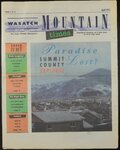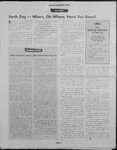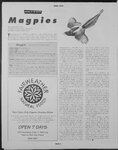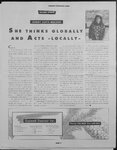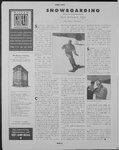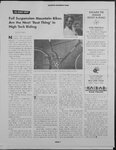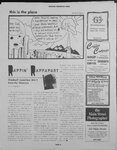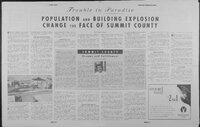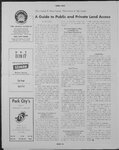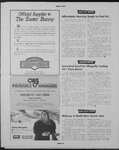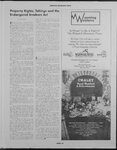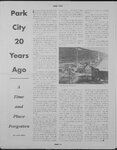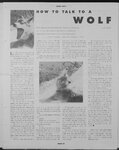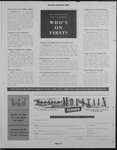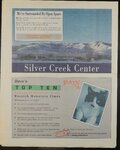| OCR Text |
Show Oe ie <p APRIL 1995 WASATCH Tr POPULAT CHANGE Ouses are sprouting up in the western end H:: Summit County, like mushrooms following rain. Ridgelines have given way to rooflines, sandhill cranes and cows grazing in expansive meadows have yielded to traffic and subdivisions Gasps are heard from visitors or former residents who haven't driven into Park City since 1990. They simply can’t believe their eyes The development that can be seen driving over Parleys Summit and heading into the Snyderville Basin, is only the beginning o a housing explosion that is quickly turning this once scenic mountain agricultural area into an urban setting — or more accurately, suburban sprawl It is as though suburban Salt Lake Valley somehow crawled up Parleys Canyon, with one important distinction — there are few services available for the stylish neighborhoods of western Summit County, save four lanes of stop pavement, lights, an outlet mall, McDonalds and K-Mart “We didn’t want to be Sandy City,” a Summit County resident said at a recent public meeting. “And we aren't,” she continued “We got the growth, but we didn’t get parks, recreation or libraries.’ That points up what has gone wrong in the Summit Park, Pine Brook, Jeremy Ranch areas, along with those in Snyderville Basin proper, like Silver Springs, Ranch Place and other developments across the highway from has been put in place. And with it, a timetable system for buildout in an organized manner, rather than in a helter skelter fashion. Is There Any Real Growth Control? Nevertheless, it appears as though the property rights advocates, otherwise known as large landowners and developers, have won the land-use debate. In the next decade or two, the potential exists for up to 10,000 more houses to be built in the west end of Summit County. And there apparently is nothing to stop it. Planning Director Fired Once in office, the first notable action by Soter and Flinders was to fire Summit County’s planning director, who had gained a reputation for holding developers to the letter of the new development code. “There wasn’t a soul on the east side of incumbent Democrat Ron Perry 6¢ e know that somewhere out there, beyond the next ridgeline is an uncluttered place where life is better. When we have been betrayed by our dreams, we simply cut our roots and move on... What brought settlers to these lands was opportunity. What keeps them here is quality of life, and the American concept of entitlement.” Those words, by James Kuntsler, resonate for everyone that’s moved to an area like Park City, or has even seriously thought about it. But in today’s West, they only tell half the story. A story that’s now being played out in the Snyderville Basin, as well as Jackson Hole, Steamboat, Sedona, and most every western resort town. The arena for this is called “planning.” But that reasonable sounding word has often come to symbolize a hard conflict of philosophies. The focus of that conflict is growth. The Snyderville Basin, roughly that area between Park City’s limits and the Interstate, is both a study of this phenomenon, and a continuing example. While today almost no one cheers this kind of explosive growth, it continues seemingly unabated. I'll try to explain how this happened, and at least define the broad issues, at convention, many Wagner supporters deserted her in favor of write-in candidate and former Park City Councilwoman Sally Elliott The control-growth vote was split and when the smoke cleared a pair who had held commission seats in the1980s had won again. The growth control forces of Snyderville Basin the county who would have supported us if we didn’t get rid of him,” Soter said of former planning director Bruce Parker. If nothing else, Parker's firing was a measure that might well symbolize an easing of the new zoning restrictions. Soter, however, said Parker’s dismissal had Wolf Mountain ski area: A rural county government allowed suburban development without the safeguards and organization that come with township incorporation. S° there is one subdivision after another, with no corresponding post office, theater, city hall or even baseball diamond. There are houses and cars and people, but there are no picnic areas, gymnasiums or libraries. Some saw the boom and the problems coming. And for the past five years, Snyderville-area residents have been squawking, meeting, and pushing for controls on growth, Along the way, a new zoning code had shot themselves in the foot, effectively canceling themselves out. Critics of newly-elected Commissioners Tom Flinders and Jim Soter, who joined Henefer resident Sheldon Richins on the board, say the pair left the door open for massive development in western Summit County when they held power in the 1980s. Both deny the allegation and point to massive development approvals in the 1960s and 70s as the problem. But it is clear that they were elected by constituents in the agriculturally-based eastern part of the county, who dislike the greater Park City area and the PAGE nothing to do with development, itself, but with his abrasive style. “The problem with Bruce was a personality thing . . . We got a lot of complaints. He just wasn’t a people person,” the new commissioner said. Be that as it may, Parker had refused to give special treatment to several powerful people in eastern Summit County, a source close to county government said. Whatever the reason for his dismissal, onlookers now expect development to proceed at a more brisk pace in Summit County. In addition, Soter and Flinders are beginning to openly question the so-called “Tier System,” which restricts development through timelines. Tier One lands can be developed 10 in TIMES Paradise ION ano BUILDING EXPLOSION THE FAC E OF SUMMIT COUNTY people it has attracted. In addition, they were supported by developers and business interests in west Summit County. And eritics are quick to point out that Flinders is in the real estate business. This has led one Snyderville resident, Ruth Wagner, to complain that she escaped the Los Angeles suburb of Sherman Oaks, only for it to follow her to Summit County. “We had people approving plans for a city, who had no experience in planning a city, but had only experience subdividing land,” Wagner said of developments in Summit County. Wagner lost her bid last November for a seat on the Summit County Commission. She had pledged to slow growth. And although she and a band of residents successfully unseated 0 wedi e MOUNTAIN By Christopher Smart now. Land in Tier Two can’t be developed for 10 years. And property in Tier Three can not be built upon for 20 years. The Tiers were intended to restrict growth to areas where infrastructure, like water, sewer and roads were already in place. But Soter said the system restricts some properties that are close to utilities, already. “The Tiering System was a stop-gap measure ... They used it to slow growth,” Soter explained. “But there is a mechanism that has ea Dreams Jeremy Ranch, 550 for the yet-to-be-started Mountain Meadow development and 818 new units in Pine Brook. Those agreements mitigate previous building approvals that were even larger in number, said former Commissioner Ron Perry. “We felt it was necessary to enter into agreements with parties that had vested rights,” he said of the previous commission, which included Park City resident Gene Moser. Perry explained that before 1992, there COUNTY and Entitlement Essay By Gary Weiss the fundamental conflicts, and the direction we've chosen for the future. For context, the population of Summit County has roughly quadrupled since 1970. Clearly, such real estate booms can’t happen without a market. Ours is more complex than the obvious ski magnet. The completion of the 1-80 link made Salt Lake an easy commute. Delta Airlines made Salt Lake a major transportation hub. Deregulation provided cheap airfares to major cities, making second homes in the Park City area, a usable reality. Park City has the best school system in Utah. Cities, then suburbs, have rapidly become dangerous and _ unpleasant. Technology has allowed:a significant number of people to run businesses from almost anywhere. And, compared to many resort towns, we were cheap. Plainly, the basin’s beautiful pastures were much more valuable for development than for cutting hay. Again, like most western resorts, as this was happening, political power remained in the hands of those who had deep roots here — often descendants, who still lived on the land, of forebears who held the original titles. Many believed that someday, their land would pay off, and felt this property was theirs to do with as they wished. Underlying this was a sense that generally, growth was good. Summit County’s development policies strongly reflected those beliefs. Through the end of the 1980s, our laws not only didn’t control development, they actively encouraged it. Apart from the question of whether to be incorporated into the code to allow exceptions,” he said. : That isn’t to mention that lands owned by Arizona millionaire developer George Johnson fell into Tier Three, meaning he can’t build for 20 years. Johnson is suing Summit County for rights to develop his land now - a proposal that would add hundreds of houses to the area. was essentially no zoning plan for western Summit County. During the period between Thousands of Units Approved In addition, Summit County recently has entered into 29 separate consent agreements with landowners and developers, who claim to have development rights before new zoning was put in place in December 1992. The agreements are aimed at circumventing a wave of potential lawsuits by developers who contend the new zoning plan robbed them of some of the value of their property. Among them are agreements between the county and developers for 228 more units approved for Ranch Place, 322 more houses at 1965 and 1984, literally thousands of approvals for building lots were granted. The approvals were apparently aimed at increasing the county’s tax base. That plan misfired. Because although the tax base has increased, it still doesn’t provide enough funding for municipal-type services, like libraries and recreation, say nothing of roads and sewer lines. To gain those things, localities within the county must form special taxing districts. Residential growth, according to most planning specialists, does not pay its own way. One planner from Pitkin County, Colo., who was among those who drastically downzoned the areas around Aspen, said existing residents pay for new development through increased taxes. “Sprawl development looks lousy and it certainly drives up taxes,” said Michael Kinsley, who was an invited panelist at a recent public planning discussion sponsored by Park City’s KPCW radio station. Suburban sprawl “is the most expensive way to deliver services,” Kinsley contended. “But more importantly, it does nothing to foster a sense of community, because to do every one of my errands, I have to take my car... I don’t get to connect with the other citizens.” When the areas surrounding Aspen were down-zoned 20 years ago, Pitkin County was sued by landowners and developers, Kinsley remembered. But not one of the suits was lost on the merits of the down-zoning issue, he said. growth is inherently good or bad, that policy created serious problems. Not driven by a comprehensive vision of the area’s future, it didn’t account for the undoubted future impacts of this new development in terms of infrastructure. Existing residents wound up subsidizing private development through taxes. Also, Summit County stood nearly alone among Utah counties in even allowing development in unincorporated areas. A problem, because by state law, counties don’t have nearly the taxing power of cities. Additionally, the vagaries of the market created a situation where approvals were granted, and development rights created, but because very little actual building occurred, even more approvals were granted. The results of this mix became frightening clear in the late 1980s and early ‘90s. The market caught up to developer's plans, and quickly Summit County became the fastest growing county in Utah. As new people moved in — often people who had come precisely to escape the results of unregulated growth elsewhere — serious questions arose about the county’s ability to deal with these issues. Continued on page 17 “The lawsuits are a given. Any community that says it won't do anything for which it will be sued, is a community about to go down the tubes,” Kinsley said. Not only is Summit County doing everything it can presently to avoid lawsuits through consent agreements, but those agreements are based, in some respects, on the previous laissez faire zoning regulations that did not ask developers to plan communities, or even demand that they organize their own subdivisions. “The prior development code had no substance to it,” former Commissioner Perry continued. “Essentially, there was no way to turn down any building project.” Perry described the new zoning and accompanying Tier System as a “state-of-theart” land-use plan, which will shepherd organized growth in unincorporated Summit County through the next 25 years. But he warned that there will be pressure to dilute the plan. “Whenever there is a change of political power, there could be a change in direction.’ T 1e former commissioner, who helped hire Parker to institute the new planning code faulted Flinders and Soter for the summary firing of the planning director “It isn’t a surprise that Bruce Parker wasn't a friend to the development community . . (But) he was not given the opportunity to correct any differences of direction with the new commission. That is grossly unfair,” Perry said. For his part, Parker said he was not told why he was fired. “You'll have to ask the commission. They didn’t tell me.” Where Is The Parade? Despite the wrangling over development in Snyderville Basin, Parker said that if the new plan is followed, it will yield a satisfying community. “The residents of Snyderville Basin have been residents there for only a shot period of time. A sense of community takes a long time,” Parker But area, the to new said. Ruth plan Wagner is almost and others as.bad in the as the old there is no community center, let alone a main street hen former Moser County suggested Commissioner at a recent Gene meeting that Kimball Junction is the natural community center for the basin, Wagner became more critical “What kind of cultural center is that? It’s a freeway offramp and some fast food places That is predicting that Park City will continue to be the center of the community for everyone out here in the county,” she said On March 20, the plan for a community center at Kimball Junction was unveiled at the Summit County offices in Coalville During the planning phase that preceded the December 1992 Development Code, Wagner contends the former Summit County Commission ignored the wishes’ of residents “It doesn’t pay to get on these (citizen) committees. The county commission created these committees . We had proposals for ordinances and planning. But they were never considered. It’s not that we didn’t try,” Wagner said one. “| don’t think it is an improvement. They didn’t decrease development, they merely organized it,” she said. “We're still getting nose-to-nose houses.” Although the former county commission and some expensive consultants spent hundreds of hours devising the new development code, Wagner maintains that they did little to organize various subdivisions into a cohesive community. “Where would they hold a parade?” she asked with a note of irony, pointing out that Lack of Water? Although Wagner and Soter have little in common, they both believe that only a lack of water can save western Summit County from over-development. A study of Snyderville 3asin aquifers is presently underway, cosponsored by Park City, Summit County and the federal government Adding to the confusion is that some 16 different companies deliver culinary water to residents in Snyderville Basin Continued on page EXTREME| VALUE]. FOR At Deer Valley, we want to thank you for an extremely great year with a great deal on ski passes. From April 3 through 9, two can ski for only $47. Theres still plenty of fantastic spring skiing, so come take advantage of this special offer. (Some restrictions apply.) Call 649-1000. DEER VALLEY UTAH 17 |

